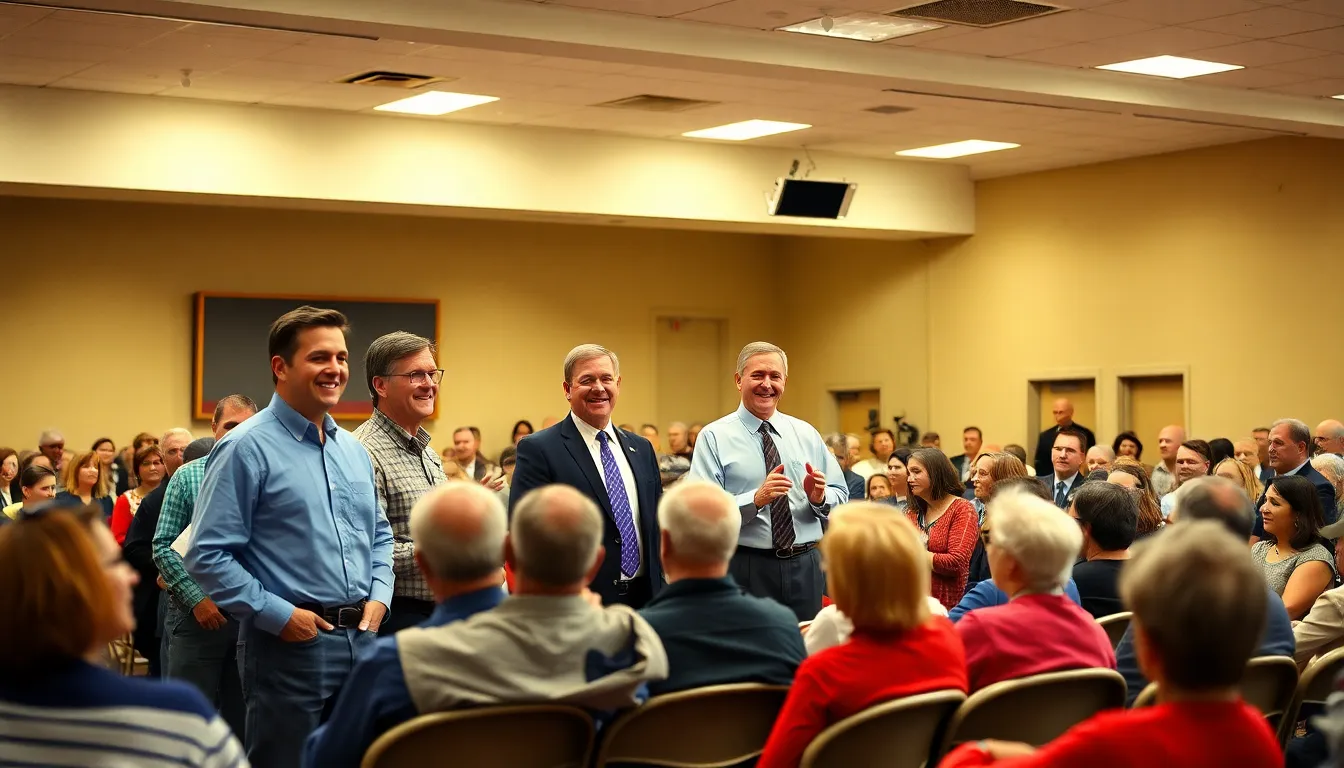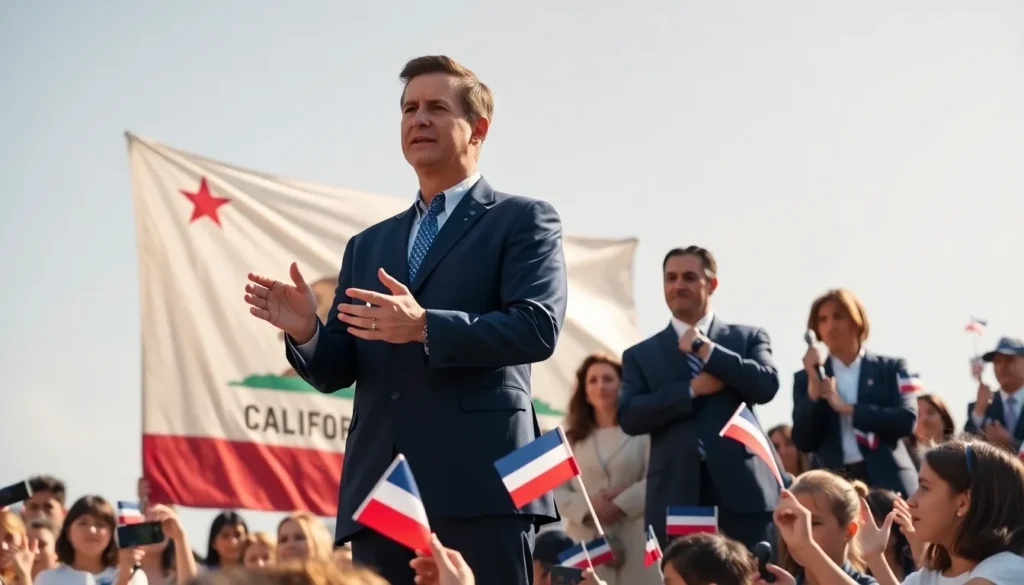Table of Contents
ToggleAs California gears up for the 2026 gubernatorial race, the Republican contenders are starting to emerge from the shadows like sunbathers at a beach party. With the Golden State’s political landscape often leaning left, these candidates are ready to shake things up and bring a fresh perspective to the table. Who knew that a state known for its avocado toast and film stars could also be the battleground for a new wave of conservative leadership?
Overview of Republican Candidates
The race for the California governorship in 2026 features several Republican candidates eager to bring conservative viewpoints to the forefront of a predominantly liberal state. These contenders represent a diverse array of backgrounds and strategies aimed at attracting voters.
Key Profiles of Leading Candidates
Candidates aiming for the gubernatorial nomination include prominent figures such as John Cox and Kevin Faulconer. John Cox, a business executive, gained recognition during his previous campaigns and focuses on economic reform. Kevin Faulconer, former San Diego mayor, emphasizes public safety and homelessness issues. Both candidates highlight their experience in governance as vital to their campaigns. Each candidate proposes distinct policy initiatives, aiming to resonate with California’s electorate.
Lesser-Known Candidates to Watch
Several lesser-known candidates may shape the dynamics of the race. Candidates like Scott Wilk and Mike Garcia offer unique perspectives. Scott Wilk, a state senator, emphasizes educational reform and fiscal responsibility. Mike Garcia, a congressman, prioritizes national security and infrastructure improvements. Emerging voices can influence Republican strategies, especially if they gain traction among grassroots supporters. The crowded field with varying viewpoints allows for potential alliances and shifts in focus as the election approaches.
Campaign Strategies

Republicans in the 2026 California gubernatorial race adopt diverse strategies aimed at resonating with voters. Candidates prioritize clear messaging and robust outreach to stand out in a predominantly Democratic state.
Messaging and Policies
Messaging focuses on core issues like economic reform, public safety, and educational improvement. Candidates emphasize the need for policies that foster business growth and tackle rising living costs. John Cox concentrates on economic revival through job creation efforts. Kevin Faulconer addresses homelessness by promoting community-based solutions. Scott Wilk advocates for educational reform to improve school performance. National security represents a priority for Mike Garcia, who links safe communities with successful infrastructure initiatives.
Outreach to Voters
Outreach efforts comprise grassroots campaigning and digital engagement. Candidates aim to connect directly with constituents through town hall meetings and local events. Social media serves as a platform for sharing messages and addressing voter concerns. Targeted ads focus on specific demographics, ensuring maximum reach in suburban and rural areas. Collaboration with local organizations strengthens community ties and bolsters visibility. Engaging in outreach fosters relationships that encourage voter participation in the election.
Challenges and Opportunities
Republican candidates face both challenges and opportunities in the upcoming 2026 gubernatorial race in California. Navigating a deeply entrenched progressive political landscape poses significant hurdles while presenting unique chances to reshape voter perceptions.
Political Climate in California
California’s political environment has a strong Democratic influence. Voter registration shows a majority leaning toward Democratic candidates, indicating a formidable barrier for Republicans. However, recent statewide trends indicate dissatisfaction with liberal policies, particularly regarding rising living costs and crime rates. This backdrop offers candidates an opening to address these concerns directly, resonating with moderate voters seeking alternatives. Shifting demographics in suburban regions further create opportunities for outreach and engagement, allowing Republican candidates to tap into new support bases that prioritize practical solutions over party loyalty.
Factors Influencing the Election
Several factors will shape the outcome of the 2026 election. Economic issues rank high on voters’ priorities, often driving decisions at the polls. Candidates presenting clear, coherent plans for economic recovery are likely to attract interest. Additionally, key topics such as public safety, housing affordability, and educational reform can sway undecided voters. Campaign strategies focusing on grassroots fundraising and digital outreach will also play a pivotal role, especially in engaging younger voters. Collaborating with local organizations may enhance credibility and foster trust within communities, leading to increased voter turnout levels. Candidates that effectively address these factors stand a better chance of influencing the election’s trajectory.
Comparisons with Democratic Opponents
Republican candidates in the 2026 California gubernatorial race confront a dynamic political landscape shaped by key issues. Economic reform, public safety, and educational improvement pose significant challenges. Many voters express dissatisfaction with rising living costs and crime rates, which provide Republicans with potential opportunities to attract moderate voters. Each candidate adopts a distinct approach, with John Cox focused on job creation and economic growth, while Kevin Faulconer prioritizes community solutions to homelessness. Educational reform resonates with voters, especially through Scott Wilk’s advocacy. In tackling national security, Mike Garcia underscores infrastructure improvements as vital.
Differences in voter bases further complicate the electoral landscape. Democrats often garner support from urban areas, appealing to diverse communities. Conversely, Republicans may find traction in suburban and rural regions, where economic and safety concerns dominate discussions. Outreach strategies are tailored to engage specific demographics. While Democratic candidates may emphasize progressive values, Republican contenders highlight fiscal responsibility and public safety initiatives. Engagement techniques, such as grassroots campaigning and digital outreach, seek to mobilize different voter segments effectively. Each party’s strategies reflect their understanding of voter priorities and regional dynamics.
The 2026 California gubernatorial race presents an intriguing opportunity for Republican candidates to reshape the political narrative in a state often dominated by liberal ideologies. With a diverse array of candidates each bringing unique perspectives and strategies, the competition is set to be dynamic and impactful.
As they prepare for the election, addressing key voter concerns such as economic reform and public safety will be crucial. The ability to connect with constituents through effective outreach and clear messaging may determine their success in a challenging political landscape.
With the potential for shifting voter sentiments, particularly among moderates, the Republican contenders have a chance to make significant inroads. The coming months will reveal how these candidates adapt and respond to the evolving needs of California’s electorate.




